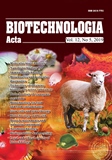ISSN 2410-776X (Online)
ISSN 2410-7751 (Print)

"Biotechnologia Acta" V. 12, No. 5, 2019
P. 79-84, Bibliography. 20, English.
Universal Decimal Classification: 628.3
https://doi.org/10.15407/biotech12.05.079
APPLICATION OF Lemna minor FOR POLLUTED WATER TREATMENT FROM BIOGENIC ELEMENTS
L. Sablii, M. Korenchuk, M. Kozar
National Technical University of Ukraine “Igor Sikorsky Kyiv Polytechnic Institute”
The aim of this work was to establish the possibility of Lemna minor usage to improve the efficiency of wastewater treatment from nitrogen and phosphorus compounds.
Due to their pollution resistanse, Lemna minor is often used for wastewater remediation. It’s capability of absorption and transformation of various compounds, promotes the deposition of suspended matter, saturates water with oxygen, intensifies the purification processes.
Due to the rapid growth rate, duckweed absorbs a large amount of pollutants, thereby purifying water from them. However, there is insufficient data and information on the efficiency of nitrogen and phosphorous compounds extraction by Lemna minor wastewater. That is why the research direction was to determine the efficiency of wastewater treatment from biogenic nitrogen and phosphorus compounds by higher aquatic plants of Lemna minor.
The necessary conditions for cultivation of higher aquatic plants of Lemna minor in autumn and winter were established. The efficiency of using duckweed of different mass for purification of waste water from biogenic compounds of nitrogen and phosphorus was investigated. The usage of duckweed together with other higher aquatic plants to investigate wastewater from biogenic nitrogen and phosphorus compounds was investigated.
It was found that the efficiency of sewage treatment in the autumn-winter period should adjust the mode of illumination and temperature regime.
Key words: wastewater, biological treatment, phosphates, nitrates, Lemna minor.
© Palladin Institute of Biochemistry of National Academy of Sciences of Ukraine, 2018
References
1. Sablii L., Kuzmynskii Y., Zhukova V., Kozar M. New technology of biological treatment of domestic and industrial wastewater. Wat. Sup. Sanit. V. 3, P. 24–33.
2. Tulaydan Y., Malovanyy M., Kochubei V., Sakalova H. Treatment of high-strength wastewater from ammonium and phosphate ions with the obtaining of struvite. Chem. Technol. 2017, P. 463–468. https://doi.org/10.23939/chcht11.04.463
3. Akpor O. B., Muchie M. Bioremediation of polluted wastewater influent: Phosphorus and nitrogen removal. Sci. Res. Essays. 2010, 5 (21), 3222–3230.
4. Wei D., Shi L., Yan T., Zhang G., Wang Y., Du B. Aerobic granules formation and simultaneous nitrogen and phosphorus removal treating high strength ammonia wastewater in sequencing batch reactor. Biores. Technol. 2014, V. 171, P. 211–216. https://doi.org/10.1016/j.biortech.2014.08.001
5. Kim Y. M., Cho H. U., Lee D. S., Park D., Park J. M. Influence of operational parameters on nitrogen removal efficiency and microbial communities in a full-scale activated sludge process. Wat. Res. 2011, 45 (17), 5785–5795. https://doi.org/10.1016/j.watres.2011.08.063
6. Zhukova V., Sabliy L., Lagod G. Biotechnology of the food industry wastewater treatment from nitrogen compounds. Biotechnol. Food Ind. 2011, P. 133–138.
7. Dytczak M. A., Londry K. L., Oleszkiewicz J. A. Activated sludge operational regime has significant impact on the type of nitrifying community and its nitrification rates. Wat. Res. 2008, 42 (8–9), 2320–2328. https://doi.org/10.1016/j.watres.2007.12.018
8. Othman I., Anuar A. N., Ujang Z., Rosman N. H., Harun H., Chelliapan S. Livestock wastewater treatment using aerobic granular sludge. Biores. Technol. 2013, V. 133, P. 630–634. https://doi.org/10.1016/j.biortech.2013.01.149
9. Wang Y., Peng Y., Stephenson T. Effect of influent nutrient ratios and hydraulic retention time (HRT) on simultaneous phosphorus and nitrogen removal in a two-sludge sequencing batch reactor process. Biores. Technol. 2009, 100 (14), 3506–3512. https://doi.org/10.1016/j.biortech.2009.02.026
10. Yang S., Yang F., Fu Z., Wang T., Lei R. Simultaneous nitrogen and phosphorus removal by a novel sequencing batch moving bed membrane bioreactor for wastewater treatment. J. Hazard. Mater. 2010, 175 (1–3), 551–557. https://doi.org/10.1016/j.jhazmat.2009.10.040
11. Lemaire R., Yuan Z., Bernet N., Marcos M., Yilmaz G., Keller J. A sequencing batch reactor system for high-level biological nitrogen and phosphorus removal from abattoir wastewater. Biodegradation. 2009, 20 (3), 339–350. https://doi.org/10.1007/s10532-008-9225-z
12. Nielsen P. H., Saunders A. M., Hansen A. A., Larsen P., Nielsen J. L. Microbial communities involved in enhanced biological phosphorus removal from wastewater – a model system in environmental biotechnology. Cur. Opin. Biotechnol. 2012, 23 (3), 452–459. https://doi.org/10.1016/j.copbio.2011.11.027
13. Yuan Z., Pratt S., Batstone D. J. Phosphorus recovery from wastewater through microbial processes. Cur. Opin. Biotechnol. 2012, 23 (6), 878–883. https://doi.org/10.1016/j.copbio.2012.08.001
14. Kadlec R. H., Wallace S. D. Treatment wetlands. Boca Raton, Fl.: CRC Press. 2009, 1016 p. https://doi.org/10.1201/9781420012514
15. Vymazal J. Constructed Wetlands for Wastewater Treatment: A Review. Proceedings of Taal 2007: The 12th World Lake Conference. 2008. P. 965–980.
16. Garc?a J., Rousseau D. P. L., Morat? J. Contaminant Removal Processes in Subsurface-Flow Constructed Wetlands: A Review. Crit. Rev. Environ. Sci. Technol. 2010, 40 (7), 561–661. https://doi.org/10.1080/10643380802471076
17. Rahimi Y., Torabian A., Mehrdadi N., Shahmoradi B. Simultaneous nitrification–denitrification and phosphorus removal in a fixed bed sequencing batch reactor (FBSBR). J. Hazard. Mater. 2011, 185 (2–3), 852–857. https://doi.org/10.1016/j.jhazmat.2010.09.098
18. Blackburne R., Yuan Z., Keller J. Demonstra tion of nitrogen removal via nitrite in a sequencing batch reactor treating domestic wastewater. Wat. Res. 2008, 42 (8–9), 2166–2176. https://doi.org/10.1016/j.watres.2007.11.029
19. Kapagiannidis A. G., Zafiriadis I., Aivasidis A. Effect of basic operating parameters on biological phosphorus removal in a continuous-flow anaerobic–anoxic activated sludge system. Bioproc. Biosyst. Engin. 2012, 35 (3), 371–382. https://doi.org/10.1007/s00449-011-0575-2
20. Beuckels A., Smolders E., Muylaert K. Nitrogen availability influences phosphorus removal in microalgae-based wastewater treatment. Wat. Res. 2015, V. 77, P. 98–106. https://doi.org/10.1016/j.watres.2015.03.018

